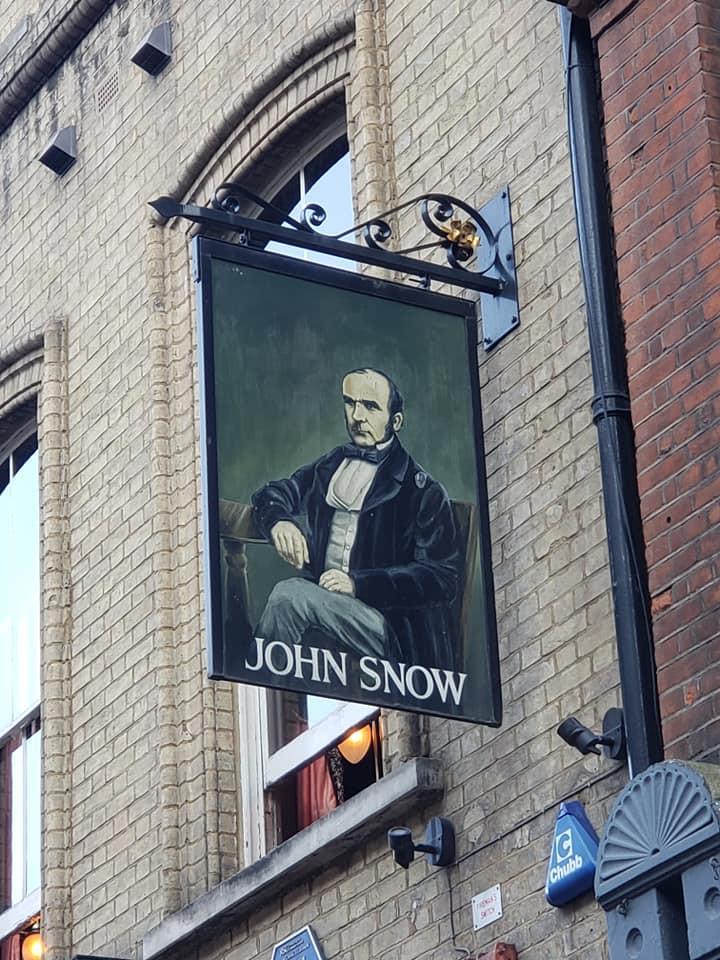|
By: Courtney Southwick This past summer, my husband and I took a trip to England to celebrate our anniversary and my graduation from my master's program. Being a health science major, I was excited to see the Broad Street pump in London. In fact, that was our first stop after we flew into Heathrow! We drove through the awful London traffic to see the pump. That spot is very exciting to me because it is the birthplace of the field of epidemiology. It’s the spot where in 1854 a physician named John Snow tracked down the source of a cholera epidemic and changed the future of medical science. Cholera was very common in London at the time. It is an acute diarrheal illness caused by the Vibrio cholerae bacterium. It is spread through the fecal-oral route, meaning people become infected by ingesting contaminated food or water. The symptoms can be severe: watery diarrhea, vomiting, rapid heart rate, and extreme dehydration of the body. The loss of fluid happens so quickly that death usually comes within a few hours. There were cholera epidemics every few years in 19th-century London and each time, thousands died. The idea that germs caused disease was very new and not widely accepted during this time. Microscopes were also very uncommon so there was no way to see the cholera bacterium. London’s poor sanitation and open slaughterhouses created a putrid smell in the air. At the time, most people assumed that the bad air, or miasma, was the cause of disease. Dr. John Snow was the only person who suspected that cholera came from the water supply. Most Londoners got their water from community street pumps. Dr. Snow interviewed survivors and found that their symptoms always started in the gastrointestinal tract. He thought that if it was caused by miasma, the symptoms would be pulmonary. He published a paper blaming it on the water, and no one took him seriously. The idea of invisible microbes infecting water and causing sickness was an outrageous idea for its time. During a particularly bad outbreak in Westminster, Dr. Snow went door to door interviewing hundreds of family members of cholera victims. Almost all of them said the victim had gotten their water from the Broad Street Pump. He felt that this confirmed his theory and asked the Board of Guardians to remove the pump’s handle. The Board did not take him seriously. It took a lot of convincing, but eventually they agreed to remove the handle, just in case he was right. The intervention worked. Soon after the pump was disabled, cases of cholera decreased dramatically. Dr. John Snow revolutionized medical science. He was the first to track down the cause of an illness and produce a hypothesis for transmission of a disease. He was the first to systematically investigate cases and propose an intervention – removing the pump handle – which prevented further cases. None of this had ever been done before. He created the field of epidemiology and his work is still highly regarded today.
My husband and I visited the pump on a weekend evening in June. People were drinking inside the aptly named John Snow pub nearby and spilling out onto the sidewalk. At the pump, backpacks and jackets were piled up as people stood nearby drinking and chatting. I began to take a few pictures when a group of men noticed and cleared the area of their belongings. They stared, curious as to why I was taking pictures of a defunct water pump. One man stopped me and asked, “Why do people keep taking pictures of this pump?” Being a student of epidemiology, I struggled to keep my explanation short. As I told him the significance of the pump, his friends leaned in to listen. After my story, one of them said, “Wow, we’ve been coming here for years and had no idea!” Together, the group raised their cups of beer and cheered, “To John Snow!”
6 Comments
Given how deadly the toxin is, it may be surprising to learn that it has legitimate medical uses. A purified form of the toxin is used in the cosmetic procedure called Botox. Exceptionally small particles of the toxin are injected into the face to relax the muscles and reduce wrinkles. Botox is the most well-known procedure, but there are 5 types of Botulinum toxin that have been FDA-approved to treat twenty-five health conditions. These include crossed eyes, muscle stiffness, excessive sweating, chronic migraines, overactive bladders, and much more. The toxin is so strong that a tablespoon could provide the world’s medical and cosmetic supply for an entire year. The Early History Botulinum toxin has a long history. Writings from ancient Greece tell of a sickness that caused paralysis, vomiting, spasms, and respiratory failure. The culprit was poorly processed sausage contaminated with botulinum toxin. In the early 1800s, Dr. Justinus Kerner, a physician and poet, published the first case study of botulism, also caused by improperly prepared sausage. He documented the signs and symptoms, performed animal studies, and even experimented on himself. He was the first to recognize that the toxin interrupted motor signal transmission and he was the first to hypothesize about the therapeutic uses of the toxin. Emile Pierre-Marie van Ermengem, a bacteriologist in Belgium, made some breakthroughs as well. In the late 1800’s, Dozens of musicians fell ill after sharing a meal. Dr. van Ermengem studied the food they ate and found that the sick musicians had all chosen to eat ham at the dinner. The doctor isolated the bacterium and named it Bacillus botulinum, from the Latin word botulus, meaning sausage. Though many types of foods can cause botulism, the disease was strongly associated with sausage by that time. World War II Because of its extreme toxicity, botulinum toxin was eyed as a possible biological weapon during World War II. Allied intelligence sources wrongly reported that the Germans were working with botulinum toxin as a biological weapon. The report specifically stated that the Germans were preparing to use the weapon during Operation Overlord, the Battle of Normandy, which launched the Allied invasion of Europe. The reports eventually were found to be false, but it launched a years-long scientific endeavor in both England and the United States. Scientists at Porton Down in England and Camp Detrick (now called Fort Detrick) in the United States were tasked with purifying the toxin to create a bacteriological weapon. The weapon was only to be used as a defensive measure against the Nazis. At Porton Down, they studied the toxin throughout World War II. They had difficulty producing batches in mass that were consistent in their toxicity. They experimented with animals but had varied and disappointing results. The scientists were working toward two goals: to put the toxin into food and to coat the inside walls of bombs. The results were discouraging. The toxin in the food couldn’t be replicated consistently and the heat of the bombs decomposed the toxin. Research at Camp Detrick wasn’t much better. President Franklin D. Roosevelt approved the research, but only to be used in retaliation after the Nazis’ deployed their bacteriological weapon. He put George W. Merck, chemist and president of the pharmaceutical company Merck, in charge. Secret work on botulinum toxin weapons began in various universities across the United States. The main center of work was at Camp Detrick, where they succeeded in creating a purified, crystalline form of the toxin. This stabilized the toxin and prevented it from becoming degraded. The Americans discussed the possibility of creating an antidote to the toxin, called Toxoid X. The antidote would be the actual botulinum toxin treated to destroy its toxicity and retain its antigenicity. In other words, it would stimulate an immune response like a vaccine, but the soldiers would not fall ill. The plan was to immunize 1.5 million Allied soldiers. New British intelligence reports then produced irrefutable evidence that the Germans did not have the ability to produce biological weapons with botulinum toxin, so plans to inoculate the soldiers were dropped. On D-day, the soldiers who landed on Normandy beach carried gas masks for chemical attacks, but not biological attacks. As the war progressed, the truth became known. The Nazis had indeed been working on biological weapons, but with mustard gas and anthrax, not botulinum toxin. Hitler also banned offensive biological weapons but assigned German scientists to study them for defensive purposes. Heinrich Himmler, a top Nazi military leader, circumvented official orders and quietly gave authority to some labs to begin research into offensive bacteriological weapons. He also ordered experiments on concentration camp inmates. Botulinum Toxin Today
Years of research on botulinum toxin during the war concluded with an understanding that it is ineffective for weaponization. That pursuit was put to rest, but the research led to the purification of the toxin and paved the way for many medical uses today. The first official medical use was for strabismus, or crossed eyes. Alan Scott, an ophthalmologist was looking for an alternative to surgery for his patients. Botulinum toxin is a localized drug; it stays in one place instead of spreading throughout the body. Dr. Scott experimented with injecting the toxin near the eyes, which relaxed the muscles and allowed the condition to improve. He named his product Oculinum. It was approved by the FDA in 1989 for strabismus, blepharospasm (uncontrolled eye twitching), and other nerve disorders. The product was eventually sold to a company named Allergan, which changed the medication name to Botox in 1991. Jean and Alister Carruthers, an ophthalmologist and dermatologist in Canada, noticed their patients treated for blepharospasm had resolution of their frown lines after treatment. They published their findings in 1992 which led to many scientists conducting clinical trials to study the safety and efficacy of using botulinum toxin to reduce wrinkles. Eventually, the FDA approved it to treat moderate to severe glabellar lines, or forehead wrinkles, in April 2002. Since then, Botox has been used to decrease facial wrinkles, but also so much more. It was approved to treat abnormal head positions and severe neck pain associated with cervical dystonia, a very painful movement disorder. The toxin is also used as a treatment for facial asymmetry caused by facial nerve paralysis. The list goes on. Because of the clandestine work of military scientists, purified botulinum toxin has helped countless people relieve their pain and live normal lives. |
Welcome to
my blog! I've been writing since I was twelve years old, and I fell in love with science in the 9th grade. In addition, I was raised by a writer and a historian, so I am here to combine my love of science, history, and writing. Join me here as I blog about the history of science and medicine. Archives |












 RSS Feed
RSS Feed